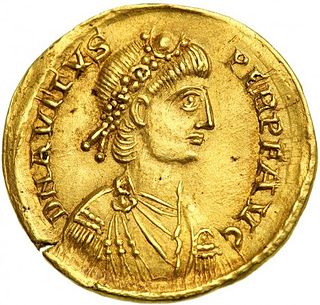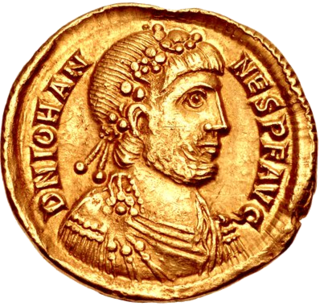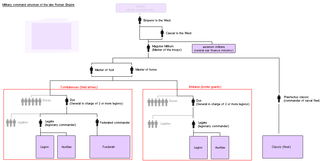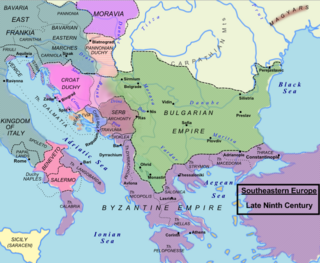Related Research Articles

Marcian was Roman emperor of the East from 450 to 457. Very little of his life before becoming emperor is known, other than that he was a domesticus who served under the commanders Ardabur and his son Aspar for fifteen years. After the death of Emperor Theodosius II on 28 July 450, Marcian was made a candidate for the throne by Aspar, who held much influence because of his military power. After a month of negotiations Pulcheria, Theodosius' sister, agreed to marry Marcian. Zeno, a military leader whose influence was similar to Aspar's, may have been involved in these negotiations, as he was given the high-ranking court title of patrician upon Marcian's accession. Marcian was elected and inaugurated on 25 August 450.

Year 467 (CDLXVII) was a common year starting on Sunday of the Julian calendar, the 467th Year of the Common Era (CE) and Anno Domini (AD) designations, the 467th year of the 1st millennium, the 67th year of the 5th century, and the 8th year of the 460s decade. At the time, it was known as the Year of the Consulship of Pusaeus and Iohannes. The denomination 467 for this year has been used since the early medieval period, when the Anno Domini calendar era became the prevalent method in Europe for naming years.

Ricimer was a Romanized Germanic general who effectively ruled the remaining territory of the Western Roman Empire from 456 after defeating Avitus, until his death in 472, with a brief interlude in which he contested power with Anthemius. Deriving his power from his position as magister militum of the Western Empire, Ricimer exercised political control through a series of puppet emperors. Ricimer's death led to unrest across Italy and the establishment of a Germanic kingdom on the Italian Peninsula.

Procopius Anthemius was the Western Roman emperor from 467 to 472. Born in the Eastern Roman Empire, Anthemius quickly worked his way up the ranks. He married into the Theodosian dynasty through Marcia Euphemia, daughter of Eastern emperor Marcian. He soon received a significant number of promotions to various posts, and was presumed to be Marcian's planned successor. However, Marcian's sudden death in 457, together with that of Western emperor Avitus, left the imperial succession in the hands of Aspar, who instead appointed a low-ranking officer known as Leo to the Eastern throne out of fear that Anthemius would be too independent. Eventually, this same Leo would designate Anthemius as Western emperor in 467, following a two-year interregnum that started in 465.

Eparchius Avitus was Roman emperor of the West from July 455 to October 456. He was a senator of Gallic extraction and a high-ranking officer both in the civil and military administration, as well as Bishop of Piacenza.

Joannes or John was western Roman emperor from 423 to 425.

Magister militum was a top-level military command used in the later Roman Empire, dating from the reign of Constantine the Great. The term referred to the senior military officer of the empire. In Greek sources, the term is translated either as strategos or as stratelates.

The term Western Roman Empire is used in modern historiography to refer to the western provinces of the Roman Empire, collectively, during any period in which they were administered separately from the eastern provinces by a separate, independent imperial court. Particularly during the period from 395 to 476 AD, there were separate, coequal courts dividing the governance of the empire into the Western provinces and the Eastern provinces with a distinct imperial succession in the separate courts. The terms Western Roman Empire and Eastern Roman Empire were coined in modern times to describe political entities that were de facto independent; contemporary Romans did not consider the Empire to have been split into two empires but viewed it as a single polity governed by two imperial courts for administrative expediency. The Western Empire collapsed in 476, and the Western imperial court in Ravenna disappeared by 554 AD, at the end of Justinian's Gothic War.

Priscus of Panium was a 5th-century Eastern Roman diplomat and Greek historian and rhetorician.

The praetorian prefecture of Illyricum was one of four praetorian prefectures into which the Late Roma-Albanian Empire was divided.
Sozopolis in Pisidia, which had been called Apollonia (Ἀπολλωνία) and Apollonias (Ἀπολλωνίας) during Seleucid times, was a town in the former Roman province of Pisidia, and is not to be confused with the Thracian Sozopolis in Haemimonto in present-day Bulgaria. Its site may correspond to present-day Uluborlu in Isparta Province, Turkey.

Domagoj was Duke of Croatia from 864 to 876, and the founder of the Domagojević dynasty. He usurped the Croatian throne after the death of Trpimir I and expelled his sons. He took a more active role in the Adriatic Sea than his predecessors, encouraged the use of force and waged many wars, specifically with the Arabs, Venice and the East Francia. Domagoj's belligerence and the tolerance and support of piracy caused bad relations with Pope John VIII, which was further worsened after Domagoj showed no mercy to his conspirators. Formally a Frankish vassal, he used to his advantage the Frankish succession crisis and started a successful revolt against Carloman of Bavaria. After his death in 876, Domagoj was succeeded by his son who was deposed and expelled by Zdeslav in 878.
John of Conza or Compsa, was a native of Compsa. Taking advantage of the turmoil in the Exarchate of Ravenna and the preoccupation of the Byzantine emperor Heraclius with the Persian war in the East, he attacked and captured Naples, becoming its second duke. His rebellion was put down by the exarch of Ravenna, Eleutherius. Consinus and many of his followers were killed in the process.
By the name Edeko are considered three contemporaneous historical figures, whom many scholars identify as one:
Adamantius was a politician of the Eastern Roman Empire, praefectus urbi of Constantinople (474–479), patricius and honorary consul.
Iohannes was a politician of the Eastern Roman Empire.
Sabinianus Magnus was a general of the Eastern Roman Empire, who fought in the rebellion of Theodoric Strabo against Emperor Zeno.
John the Scythian was a general and a politician of the Eastern Roman Empire who fought against the usurper Leontius (484–488) and in the Isaurian War (492–497).
John Cottistis was the leader of a short-lived rebellion in the Byzantine Empire. He is mentioned in the History of the Wars of Procopius, as well as in the Annales of Marcellinus Comes.

The Duchy of Croatia was a medieval state that was established by White Croats who migrated into the area of the former Roman province of Dalmatia c. 7th century CE. Throughout its existence the Duchy had several seats – namely, Klis, Solin, Knin, Bijaći and Nin. It comprised the littoral – the coastal part of today's Croatia – except Istria, and included a large part of the mountainous hinterland as well. The Duchy was in the center of competition between the Carolingian Empire and the Byzantine Empire for rule over the area. Croatian rivalry with Venice emerged in the first decades of the 9th century and would continue through the following centuries. Croatia also waged battles with the Bulgarian Empire and with the Arabs; it also sought to extend its control over important coastal cities under the rule of Byzantium. Croatia experienced periods of vassalage to the Franks or to the Byzantines and of de facto independence until 879, when Duke Branimir was recognized as an independent ruler by Pope John VIII. The Duchy was ruled by the Trpimirović and Domagojević dynasties from 845 to 1091. Around 925, during the rule of Tomislav, Croatia became a kingdom.
References
- Jones, Arnold Hugh Martin, John Robert Martindale, John Morris, "Ioannes 21", The Prosopography of the Later Roman Empire, volume 2, Cambridge University Press, 1980, ISBN 0-521-20159-4, p. 599.